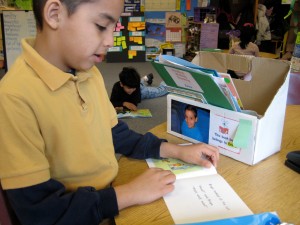 As I was sitting in For Eyes the other day waiting for my new glasses, I noticed the wallpaper was composed of running words that were synonyms for the word “look,” very apropos for an eyeglass store. Written continuously it said, “peep, spy, view, gander, glance, survey, scan, investigate, skim, gape, google, peer, look, stare, gaze, inspect, scout, notice, glimpse,” and there were many more. Who knew there were so many varied meanings for basically the same word!
As I was sitting in For Eyes the other day waiting for my new glasses, I noticed the wallpaper was composed of running words that were synonyms for the word “look,” very apropos for an eyeglass store. Written continuously it said, “peep, spy, view, gander, glance, survey, scan, investigate, skim, gape, google, peer, look, stare, gaze, inspect, scout, notice, glimpse,” and there were many more. Who knew there were so many varied meanings for basically the same word!
As I left, I couldn’t help but think about our English Language Learners (ELLs). There is so much vocabulary for them to learn! But I also thought about how important it was that we continuously expose them to new vocabulary, not white out or cover up unknown words in the books they are reading. It is through frequent exposure that they will acquire such synonyms or varied connotations of vocabulary words. As teachers, we need to provide experiences with new vocabulary within the context of reading real books and writing authentic messages together.
When we are reading with a child, we try to be aware of:
1) when the child can pronounce the word but is confused because the word means something different in this situation, or
2) the child has the concept of the word, but the particular vocabulary word in English might be new for him, or
3) the child has neither the ability to recognize or pronounce the word and also does not have a concept for that word.
For each of these situations our support would differ.
In the first instance, the child may be able to read “’Come quickly!’ she cried’” but may only know the word “cry” as “shedding tears.” Teacher support may be necessary for helping the ELL understand that the word is being used in a new way. In the second instance, the child may be able to figure out what the word might mean by using context clues. He may know that something very funny just happened in the story and that’s why the character said, “That was hilarious!” even though the word hilarious is not in his speaking vocabulary. Support from the teacher may be necessary to help the ELL realize the connection between funny and hilarious. In the third situation, the ELL might not have the concept of the word as well as not being able to solve the word. For example, some children may be unfamiliar with a hearth or a scarecrow or a skyscraper. In this instance we not only have to help the child with word solving skills to be able to pronounce the word, but we also have to build the meaning of the vocabulary word with pictures or gestures or a more detailed explanation.
This week try paying close attention to the English language in the books your students are reading. What examples are you noticing of vocabulary that might be tricky for an English Language Learner?
For further reading on this topic, see Chapter 7 of One Child at a Time (Stenhouse) where Pat and Katie work together to improve their book introductions for ELLs.
I believe non-ELL students may experience the same difficulties mentioned above. For example, students who live in poverty or those who are part of the foster care system often suffer from a lack of exposure to vocabulary-rich environments. For that reason, they can benefit from the same instruction or intervention that ELL students are offered. Is there any research to support my thinking?
Cindy – Thanks for your comment. I agree with you that there are many native English speakers who would have similar problems, but I’m not aware of any research to support this. Years of experience is all I have to back that up. Pat Johnson
Wonderful Post Pat! The more awareness we raise in our teachers about the importance on vocabulary, words, meaning, the more we’re helping our students, especially our ELLs.
Cindy, I believe the work of Ruby Payne supports your thinking. I work in an urban school and we all go to the Ruby Payne training which is a Framework for Understanding Poverty. All of us really enjoyed this training and provides some helpful insight on some important aspects in teaching and learning!